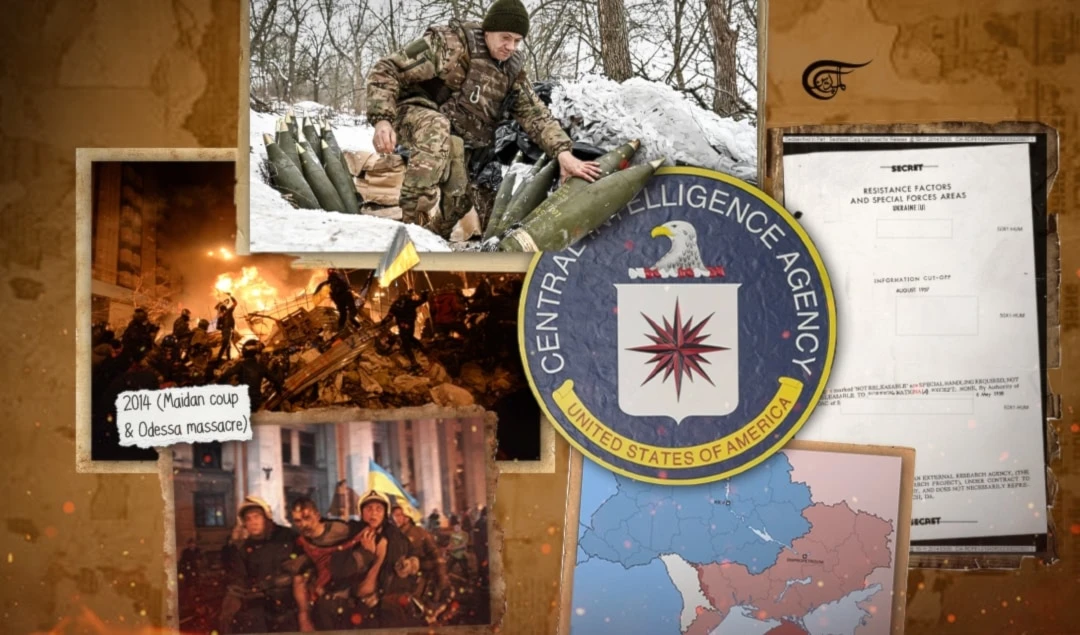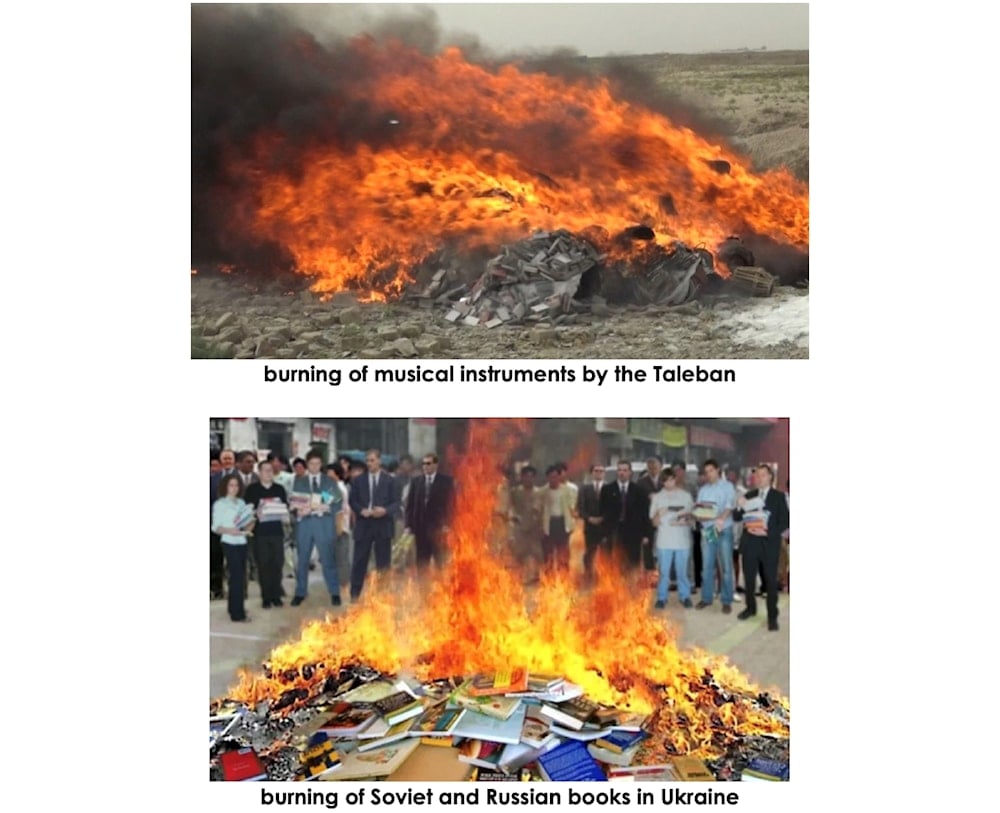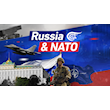The Ukrainisation of Afghanistan
Tariq Marzbaan warns that Afghanistan is becoming a new front in the global civilisational war, weaponised by the West to sabotage multipolarity, while the Taleban’s Pashtun supremacy project echoes the ideological purges seen in Ukraine and Zionist "Israel".
-

Though the Taleban are not actually waging any war at the moment, like the Ukrainians/NATO and the Zionists/US-UK-EU, they share the same seedbed and are ultimately being used for the same purpose. (Al Mayadeen English; Illustrated by Zeinab el-Hajj)
When the Taleban returned to power in Afghanistan four years ago, most observers felt that the country had been set back by 1,400 years. That may be true in a religious and social sense. Politically, however, it is more of a return to the 19th century, to the old "Great Game" between regional and Western colonial powers… but with a slight twist: The old 19th century "Great Game" is once again set in Central Asia, but this time it is being played by the new Empire – on the other side of the Atlantic – and this time it is against the BRICS+, the Belt and Road Initiative and a multipolar world. And it will be played out – to the end.
Due to the ideological intransigence of the Taleban leadership (everything depends on the will and decisions of their supreme leader, the invisible Amir Haibatollah, allegedly based in Kandahar) and their inability and unwillingness to adapt to the conditions and demands of our time, they have so far been denied the recognition they desire in order to forge ahead and prosper. International recognition of the Taleban (as expressed by individual governments and in a UN resolution) has always been subject to criteria that they have not only failed to meet but have even flouted, such as the rights of women.
Nevertheless, more and more states are moving towards establishing political, diplomatic, and economic relations with the Taleban regime… evidently for their own immediate advantages.
Russia has decided – perhaps out of wishful thinking – to "vindicate the Taleban, at least in the Russian political and legal sphere": The Russian embassy in Kabul always remained open and operational; the Afghan embassy in Moscow was entrusted to the Taleban regime; Taleban "politicians" were invited to Moscow and, conversely, the Russian Special Representative for Afghanistan (Zamir Kabulov) and other representatives of Russia visited the country and held talks with the Taleban. And all this took place despite the fact that Russia and many other countries in the region had blacklisted the Taleban as a terrorist organisation.
Other countries in the region have also proceeded in more or less the same way in their dealings with the Taleban. China, Iran, Uzbekistan, and Kazakhstan have actively engaged in economic activities in Afghanistan under Taleban rule. Their relationship with the Taleban is, however, neither de facto nor de jure, but something in between – probably a unique case in international relations.
Could this be another case of "too much trust only to be deceived and stabbed in the back later on"? Or... are they (once again) copying the show from the Western funfair's cabinet of curiosities and aim to trim Mullah Haibatollah's shaggy beard, dress him in a Chinese-made Armani suit, put a silk tie round his neck, and then present him as the Afghan version of Al Jolani? But first, they would have to find him. And whether he would let them do all that to him is another story.
"The enlightened ruler is heedful, and the good general full of caution."
– Sun Tzu
The global capitalist feverish pursuit of ever more resources and the (understandable) impatience to create corridors of commerce for a growing multipolar world has prompted many to interact with the Taleban.
But with these hazy, indiscriminate dealings with the Taleban – which amounts to a "half-hearted recognition" of their validity – many states are overlooking the potential risks ahead and what they may be setting themselves up for.
The first step in dealing prudently with a new potential partner is to know who they are… to know their history.
Some historical perspective…
Back in the 1980s and 1990s, the first generation of the Taleban were mere innocent, defenceless children of school or kindergarten age. They were mostly sons of Pashtun farmers and orphans from tribal areas in southern Afghanistan. In the madrassas around Peshawar, but also in other places in Pakistan where they were sent, they received a Deobandi-Wahhabi "education". Unsurprisingly, these schools were designed by the CIA and MI6, financed by the Saudis and the Emirates, administered by Pakistani authorities, and managed politically and militarily by the Pakistani intelligence agency ISI. There was no shortage of fanatical Afghan and Pakistani mullahs who were eagerly willing to serve as "teachers and educators". After their "training", these "pupils" were then deployed, in conjunction with one of the Pashtun-affiliated Islamic mujahideen organisations, to fight in the war against the Soviet army and the Afghan government.
After the withdrawal of the Soviets (in 1989) and the collapse of the Afghan government (in 1994), a struggle for state power in Kabul broke out between the two parties: the Hezbe Islami (consisting predominantly of Pashtuns) led by Gulbuddin Hekmatyar and the Jamiate Islami, consisting predominantly of Tajik combatants under the political leadership of Rabbani and under the military command of Ahmad Shah Massoud. It was Massoud who then succeeded in capturing the city of Kabul and thus attained state power with the help of the Uzbek militia led by Abdul Rashid Dostum.
For the second time in Afghanistan's recent history, state power fell into the hands of non-Pashtuns with a Tajik leader – a thoroughly unacceptable circumstance for Hekmatyar and his party, who promptly attacked Kabul from the south, thereby triggering a devastating civil war. The Tajiks' seizure of power – which they had been willing to share with others – was also unacceptable to the Pashtun tribal leaders and the Pashtun (secular) supremacists/chauvinists. Even Marxist former members of the PDPA (the People's Democratic Party of Afghanistan) withdrew to their respective ethnic groups or "linguistic groups" (some Pashtun "Marxists" even found themselves later amongst the Taleban).
In the meantime, the Hezbe Islami Party disintegrated, and the Pashtun claim to state power could no longer be fulfilled.
In 1994, the country was thrown into turmoil and fragmented into various ethnic clans, special interest groups, assorted political parties, and local armed units that fought each other or changed sides.
In addition, criminal gangs (either linked to the warring parties or to independent entities) flourished, which only exacerbated the misery of the population. The entire country descended into chaos and anarchy. Parts of Kabul were destroyed. Women and children were particularly hard hit. The number of civilian casualties was estimated at between 30,000 and 60,000.
With the disintegration of the Hezbe Islami Party, the Pashtuns feared the end of their exclusive rule over the country if they did not have a strong military force to fall back on, as an alternative. This alternative was presented to them by Pakistan – in the form of a new "initiative" known as the Taleban Movement, which enjoyed the active support of the Pakistani military and its secret service, the ISI.
The 10-year war (1979-1989) between the Afghan "Marxist" government (under the protection of the Soviet army) and the various resistance groups in the country was, in essence, a proxy war waged for their backers: The government in Kabul was supported by the Soviet Union; the opposition Hazara parties were under the influence of Iran; and the Uzbek militia cooperated with the Kabul government and the Soviets. Practically the entire opposition was under the influence and control of Pakistan, with extensive support from NATO and Western countries… including the Tajik Jamiate Islami – excluding, however, one particular faction: Commander Ahmad Shah Massoud and his fighters in the rugged valleys of Panjshir.
When the Taleban entered the scene in 1994, they began their rapid advance from the south against the rest of the country. Soon, they controlled the entire country – with the exception of Panjshir, Andrab and Badakhshan in the north-eastern regions of Afghanistan, where Ahmad Shah Massoud still held his position.
With the capture of Kabul, the first phase of the Taleban mission – the "reconquest" of state power in favour of the Pashtuns and the proclamation of the Islamic Emirate – was accomplished. The second phase was the introduction of Sharia law according to their Wahhabi-Deobandi-Pashtun interpretation. (Once again, women were the worst affected victims.) The Taleban did not proceed to any subsequent "phases", because their temporal and spatial exercise of power (1996–2001) was limited. And then the NATO invasion led by the United States put an end to their rule.
But the 20-year "hiatus" before their recent return to power has given the Taleban the opportunity to advance much further in achieving their goals this time around. And now almost everything is proceeding in their favour…
The shadowy architects of Pashtun supremacy
While the resources, financiers, ideologues, and spiritual leaders of religious issues and doctrines are known and openly traceable, the architects of Pashtun supremacy and the exclusively Pashtun claim to power remain in the shadows and rarely express their opinions and theories in public. These individuals nevertheless wield great influence within the Taleban structures and can be divided into two groups:
1. The old Pashtun nationalists: the ideological roots of this group date back to the 19th century to the time of Amir Abdollrahman, who built pyramids out of the heads of his alleged or actual opponents, brutally slaughtered the Hazara, and forced their women, daughters, and boys into slavery. On the advice of British intelligence and British military officers, he undertook the violent expulsion of the Hazaras and the resettlement of the Pashtuns in non-Pashtun areas (in the north of the country and elsewhere).
Since then, the notion of autocratic rule has become an integral part of "Afghan"/Pashtun political culture… The Pashtuns saw all of Afghanistan as their conquered property and felt entitled not to share state power with other ethnic groups. The Pashtun elites made several attempts to pashtunise the entire country and society. However, apart from minor successes in the geographical sphere (changing place names) and to a lesser extent in culture and education (replacing some terms in the Pashto language), they were unable to achieve any significant results.
Only in the second half of King Mohammad Zahir's 40-year reign (1936-1972) was a half-hearted attempt made to involve non-Pashtuns in the exercise of state power at a higher level (up to prime minister). However, this attempt was stopped by the coup d'état of the king's cousin Mohammad Daoud (1972).
2. The returnees from "Farangestan" (Europe): The concept of Pashtun autocracy was further developed and disseminated by returnees from Europe after Afghanistan gained "sovereignty" in the early 20th century. Those who had studied or lived in European countries, especially Germany, brought home one of the most devastating achievements of modernity: fascist-tinged nationalism. Young enthusiastic supporters of German Nazi ideology found an intellectual and active patron in the court of King Amanollah – in the person of the king's father-in-law and foreign minister, Mahmoud Tarzi.
It should be noted that, at that time, not only "Afghan"/Pashtun elites were influenced by European fascist ideology, but also the Tajiks in Afghanistan and the elites in Iran, which was then still known in the West as "Persia". Under this influence, the terms "Aryan", and Iran/Iranian were reinterpreted and given a subliminal racist/chauvinistic slant, which later manifested itself particularly in the cultural sector during the reign of Mohammad Reza Shah Pahlavi (son of Reza Khan Pahlavi). Even a line in a couplet in the epic Shahnama by the poet Ferdowsi – "culture is to be found amongst Iranians alone" – was wrenched out its literary and historical context to suddenly serve as a justification for "Iranian cultural purity and the superiority of Iranians".
The Pashtunisation Process remains in full swing
Since my earlier three-part essay on the "Pashtunisation" of Afghanistan (Part 1, Part 2, and Part 3), published almost two years ago, recent reports coming out of Afghanistan are showing that the process of "Pashtunisation" has gathered increased momentum under Taleban rule. A wave of dismissals in many state authorities and organisations has swept across the country in the past months. Those affected are Persian-speakers (Parsiwans /Tajiks) who are mainly civil servants and employees in the media and education sectors.
The attack on the Persian language continues, even though Persian has always been the lingua franca of Afghanistan and is generally spoken and understood throughout Afghanistan, alongside regional languages… and even though Pashto is merely a regional language spoken only by Pashtuns.
The use of certain Persian words and terms in official texts and announcements is either prohibited or vilified and can easily lead to reprisals from the Taleban.
In this sense, most Pashtuns in Afghanistan today are increasingly resembling the Russophobes in Ukraine and the Baltic states. Like the Ukrainians, they would prefer to ban the Persian language and the identity and culture associated with it once and for all. But fear of social unrest and strong resistance from non-Pashtuns, which could easily lead to insurrection and civil war, is forcing them to exercise caution. For the moment.
Another Useful Instrument in the Civilisational War
Understanding that the Taleban's hostile attitude toward the Persian language – not to mention their condemnation of music, poetry and the visual arts (especially images of living things) – which ultimately displays a contempt for human civilisation as a whole – should make it clear why they have easily and often resorted to terror acts and why they can have dealings with and even host other terror groups.
The Taleban's rejection and condemnation of a language, of an entire culture – indeed of a people – is yet another example of the same mindset that seeks the destruction of anything "Russian" by the Ukrainians, (as well as by the Baltic chihuahuas and the entire West) and of anything "Palestinian" by the Zionist occupation. (Somehow, they resemble the Axis Powers during WWII) All three instances are blatant examples of not only a belief in their "racial" supremacy – likely attributable to an inferiority complex and delusional disorders – but also a malignant mindset that, in its "malignancy", will not be "cured" by any "negotiations" or "friendly deals"… and will indeed only metastasise to other areas.
Thus, it is not surprising that a network of terror groups – one of the Empire's most important instruments in creating chaos and constant destabilisation in the non-Western world – is quietly waiting in Afghanistan for their deployment.
But how many times have some states been advised not to blindly trust certain opponents… only to find themselves deceived and aggressed by them later? The enemy of my enemy is not always my friend.
Though the Taleban are not actually waging any war at the moment, like the Ukrainians/NATO and the Zionists/US-UK-EU, they share the same seedbed and are ultimately being used for the same purpose… to be proxies and spanners in the works of the creation of a new more just multipolar world.
* * *
The recent ever ever-disturbing developments in both West Asia and Ukraine, and now "Israel's" illegal and nefarious war of aggression against Iran, give rise to justified concerns that attempts may soon be made to launch terror attacks on China and Central Asian states.
Waiting in the wings in Afghanistan are terrorist groups from China and Central Asian countries. Al Qaeda never left Afghanistan. The DAESH faction (ISIS) known as "DAESH Khorasan" (ISIS-K) is being encouraged to establish a stronger foothold in Afghanistan. According to reports, DAESH combatants in Syria receive a salary of up to $4,000 a month… Just a third of that amount would be enough in Afghanistan to lure young men and dissatisfied combatants within the Taleban ranks, severely affected by poverty and a lack of prospects, to join DAESH. Thus, one can already expect many minor and major conflicts in the region. Faced with such prospects, my grandmother would say: "May God have mercy on us."
UPDATE: According to reports, Mossad has established a base at an airport in western Afghanistan, where Israeli agents and Iranian fifth-column activists are being trained in the use of drones and then sent to Iran. More on this soon in a special article for Al-Mayadeen…

 Tariq Marzbaan
Tariq Marzbaan
 15 Min Read
15 Min Read














